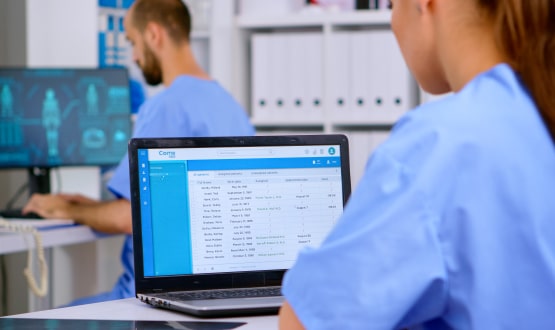Two become one
- 7 September 2012

A trust merger can be a major headache for the IT teams involved, as they have to adapt their own working practices, while standardising infrastructure, administration and clinical systems.
But it is a headache that an increasing number of IT directors will have to work through, as the current wave of trust mergers gathers pace, driven by the latest NHS reforms and financial pressures.
Basingstoke and North Hampshire NHS Foundation NHS Trust merged with Winchester and Eastleigh Healthcare NHS in January this year, after the latter was forced to acknowledge that it could not achieve foundation status on its own.
The IT director of the newly formed trust, Andy Thomas, describes it as a “very complex business”, bringing together a number of disparate systems under one roof while saving money and managing people’s expectations.
One of his key priorities is making sure that staff are mobile so that, for example, nurses in Basingstoke can work in Winchester or vice versa. This is crucial for the trust, which needs to make sure it has safe levels of clinical cover at both sites, within the resources available.
Portal project
To achieve its aims, Hampshire Hospitals has embarked on the development of a web-based portal to provide staff with access to its various systems in one place.
Intended to be platform and device agnostic, this will provide an electronic patient record for the trust while it pursues a ‘best of breed’ strategy – adding specialist systems to the IT that it already has in place.
Thomas has a small in-house development team of three developers and one programme manager, along with an in-house testing team, training team, solution development team and some external resource. Working on an open source model, the aim is for the team to deliver on projects regularly and quite cheaply.
Thomas always knew he wanted the EPR project to be open source. “I have come from an open source kind of environment; one of the companies I worked for in the City did that,” he explains.
He is working with Leeds Teaching Hospitals NHS Trust, which already has a high profile open source clinical portal project underway. “We’re hoping to share some of the expertise if there’s genuine synergy,” Thomas says.
The first development project is a hand-over tool, which takes feeds from the patient administration system to provide ward views for clinical staff, and which has generated interest amongst other trusts.
The tool is in place in Basingstoke and will be rolled out to the trust’s district general hospital in Winchester and war memorial hospital in Andover this month and next.
Thomas believes the high level of cynicism about IT in the NHS means it is important to deliver on a regular development cycle, driven by the needs of clinicians.
“They [clinicians] say what they want and we say how long it takes to deliver and we decide how to deliver that. We are looking at a six-week delivery schedule,” he adds.
“It’s a hard journey as the NHS environment is fundamentally not used to doing development. We need to train the team into proper development life cycles, not ad hoc like we have done before.”
On the road to a single electronic patient record
Hampshire Hospital’s IT team was reduced by 25% in the merger and the department is facing a budget cut of 4-5% this year.
The trust has 5,000 end user devices of which around 1,100 are at the end of life. “It’s not a brilliant picture, but probably consistent with other trusts,” Thomas shrugs.
A clinically lead IT steering group is looking at the future of its 251 applications. “Pulling these together will be difficult. That’s our biggest challenge – how to make that sensible,” he adds.
Basingstoke uses a CSC (iSoft) patient administration system and the same company for its maternity system. It uses Newgate Technology’s Sapphire theatre system, Sunquest ICE for order communications, and MSS’s Patient First in the emergency department (A&E).
Winchester and Eastleigh, however, was a prominent and early adopter of Cerner Millennium as part of the National Programme for IT in the NHS. It is using the system for patient administration, order communications, theatres and maternity.
Despite this, it recently switched-off Cerner in the emergency department of Winchester’s Royal Hampshire County Hospital, which is now using Patient First.
Thomas says clinicians have also chosen to also deploy Sapphire across all theatres and ICE for all order communications. The decision about which PAS and maternity system to use is still to be made.
As Winchester and Eastleigh got Cerner through NPfIT, it will have the license for the software in perpetuity. However, the implications of this for the merged trust are unclear. “With the Cerner contract, nobody knows if we can use the license for the whole trust,” Thomas explains.
“What we know for sure is what iSoft (CSC) costs, and what it would cost to roll it out to Winchester. But we can only guess what it means for Cerner, and we’re working on that because we don’t just want to throw things out.”
Many clinical staff still work mostly on paper, with only some notes entered into either the Cerner and CSC systems; but the trust is on a journey to rid itself of paper.
An electronic document management solution is now part of the EPR, although it involves a lot of scanning, which Thomas would like to move away from.
“I don’t think the journey will ever end. As we bring on new technology I think the EPR will constantly grow and expand,” he adds. “The biggest problem is getting traction; to get people to believe in that system you are creating.”
Other aims
Hampshire is keen to use cloud technology for server and desktop delivery and will be embarking on a procurement exercise over the next year. As part of this it will look at the G-Cloud; the government programme created to try and drive efficiency across the public sector.
Thomas argues that a virtual desktop arrangement will support better staff mobility and says the trust is 80% cloud ready with most servers and applications virtualised.
“I don’t think server rooms are really our core strength and it [cloud] is just easier. I’m convinced about the security. But we are not running at it like lemmings off a cliff; we’re taking our time over it.”
The trust has a strong network and infrastructure and wants to be able to give access to patients via a wi-fi connection onsite.
It is also looking at moving towards a ‘bring your own device’ policy, which will involve working closely with the information governance team.
“It’s not something anybody has really cracked yet,” Thomas says. “Personally, I would encourage it because it’s cheaper and easier, and the train is going to hit us anyway.”
There is not specific pot of money for the transition to the new IT environment at the trust, so each individual project must have a business case approved. However, an IM&T strategy outlining the general direction has been approved by the board.
Thomas says that while identified benefits can be financial, operational or clinical, the key requirement is that it must be possible to measure them.




